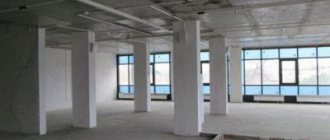Real estate is usually divided into residential and non-residential. The first includes premises where people legally live: apartment buildings, dormitories, private houses. The housing stock also includes hotels.
Non-residential property is most often used for commercial or public purposes.
The need to transfer housing from one fund to another arises for many: for entrepreneurs who bought housing in a house for a store or for conversion into an office.
If such a need arises before you, there is no need to get lost. There is a possibility of transferring the apartment to another fund.
Is a garden house a residential or non-residential premises?
Based on the above, a garden house can be considered both a residential and non-residential building, it all depends on its condition, arrangement and many other factors. Until 2021, the concept of “garden plot” was divided into several others. It was allowed to build both residential and non-residential buildings. And if the building was at one time registered as residential, then after 2021 no amendments are required. The house will automatically receive residential status.
On the other hand, if the house is being built after 2021 or has not previously been registered as residential, it will first have to be given the status of a residential building. Otherwise, you will not be able to register in it.
What premises cannot be used as housing stock?
From the point of view of the law, the emergence of the legal status of residential premises in a non-residential building is excluded. According to the legal definition of the term “residential premises,” one of its immediate features is the presence of registered citizens living in its area. Non-residential real estate, on the contrary, cannot be legally recognized as a place of residence.
Therefore, it is legally impossible to register there. This will be the main difference between non-residential and residential buildings.
This rule was established by Decree of the Government of the Russian Federation dated July 17, 1995 No. 713. However, if a citizen arbitrarily occupied non-residential premises belonging to him by right of ownership for the purpose of living, no one has the right to evict him from there, however, in this case administrative liability may be imposed for lack of registration .
To date, the law does not provide for the status of residential premises in a non-residential building.
What is the best way to register a country house?
If the country house is already registered as a residential building (until 2021) and the only problem is to give it an address (and get the opportunity to obtain permanent registration), then it is enough to contact the local administration and demand that a real address be assigned to this property. Usually this is done on demand.
If the house is not yet residential, you will have to first recognize it as such and only then require an address to be assigned.
Procedure
- Order a technical report. Since a commission is not appointed to inspect the house and the decision is made only on the basis of the documents provided by the applicant, such a conclusion from any qualified expert who has all the necessary licenses is mandatory. The conclusion indicates all the basic information with which the administration can decide whether to consider a given house residential or not.
- Prepare all documents (see sample list below).
- Submission of documents and applications to the MFC (My Documents) or local administration.
- Waiting and receiving a decision.
- Making changes to Rosreestr.
- Request to assign a house address.
Documentation
The main point in the procedure for recognizing a house as residential is contacting the administration or the MFC. To do this you need a certain list of documents:
- Expert opinion regarding the condition of the house.
- Application to the MFC or local administration (filled out on site).
- Passports of all property owners.
- Notarized consent of all property owners to change its status.
- Permission from the guardianship authorities if there are minors among the co-owners.
- Extract from the Unified State Register of Real Estate.
- Technical passport and cadastral passport.
- Legal documents.
Expenses
Despite the fact that the procedure for transferring a garden house to residential status is formally free, in fact you will have to incur some costs associated with the preparation of documentation and subsequent registration of changes:
| Type of expenses | Approximate amount |
| Technical conclusion | From 15 thousand rubles |
| Notarial consent of owners | From 1 thousand rubles for each owner |
| Changes in Rosreestr | 2000 rubles |
| Extract from the Unified State Register of Real Estate | 350 rubles |
| New technical passport | From 10 thousand rubles |
| Document recovery | From 5 thousand rubles |
Deadlines
The timing largely depends on the applicant himself, but there are some points he cannot control:
- Drawing up a technical report: up to 3 weeks (less often, more).
- Receiving a decision from the administration: up to 45 days from the date of submission of all papers.
- Registration of changes in the registry: up to 2 weeks.
FREE CONSULTATIONS are available for you! If you want to solve exactly your problem, then
:
- describe your situation to a lawyer in an online chat;
- write a question in the form below;
What are residential and non-residential premises
Real estate is usually divided into residential and non-residential. The first includes premises where people legally live: apartment buildings, dormitories, private houses. The housing stock also includes hotels.
Non-residential property is most often used for commercial or public purposes.
The need to transfer housing from one fund to another arises for many: for entrepreneurs who bought housing in a house for a store or for conversion into an office.
If such a need arises before you, there is no need to get lost. There is a possibility of transferring the apartment to another fund.
What is classified as auxiliary space at facilities?
The auxiliary (auxiliary, non-residential) area in a private house consists of the square footage of the toilet and bathroom, storage room, corridors, and kitchen area. The same parts of the space are considered non-residential and in the apartment.
Expert opinion
Makarov Igor Tarasovich
Legal consultant with 8 years of experience. Specialization: criminal law. Extensive experience in document examination.
The use of non-residential space is dictated by the need to ensure real year-round habitation of people in such a home. Unheated areas of a garage, basement, or attic of a private house do not fall into this category.
Such concepts, regulated by the Rules for the maintenance of real estate objects (Resolution of the Government of Russia of August 13, 2006, No. 491), include stairs and platforms on them, elevator shafts, places for storing strollers, bicycles, technical floors and technical basements.
The non-residential area of an apartment building is determined by summing the square footage of the built-in non-residential premises with the commercial objects located in them that are part of it. The calculation of the area of shops, pharmacies, restaurant businesses, banks, gyms is carried out according to general rules, provided that their height is at least 1.8 meters.
Why translation is needed
Transferring your home from residential to non-residential and vice versa may become necessary for many reasons.
Most often, businessmen convert purchased apartments into shops, pharmacies, restaurants and cafes, and offices.
The status of residential premises is needed because only in it you can register and live too.
If you decide to convert your property to non-residential use, consider whether this process can be avoided.
According to the Housing Code, Article 17, it is possible to engage in commercial activities in a residential area in some cases, under which the following conditions are met:
- Your house and apartment neighbors will not suffer from your activities;
- The house in which your home is located does not belong to a dilapidated building;
- A potential entrepreneur is registered in the area where he plans to do business.
However, in most cases they still prefer to change the status of housing, and this has its advantages.
The main benefit of the owner who transfers his apartment to non-residential stock is that it becomes more expensive by about 20% when sold.
But here you may encounter another difficulty: will you be able to sell your non-residential property later? How interested will an entrepreneur be in this? So, before you run for profit, you need to calculate all the risks.
The downside for you here will be the wasted time on paperwork and searching for buyers.
While the property is idle waiting for a buyer, you will have to pay utility bills, which are approximately twice as high for non-residential premises . You will also have to pay property tax , namely 2.2% of the residual value of the premises every year.
That is why the translation is carried out by the entrepreneurs themselves who bought housing.
Is it acceptable to distinguish between the name of a structure and its use?
In practice, a situation is possible when part of the building has a non-residential purpose. Bars, shops, hairdressers and cafes located on the first and ground floors of houses have exclusively commercial purposes. Thus, they cannot have the status of “residential premises”.
According to the provisions of Art. 22 of the Housing Code of the Russian Federation, the presence of non-residential premises in a residential building is possible subject to the following conditions:
- if it has a separate gladdened entrance;
- it is not part of the residential premises;
- no one lives in it;
- there are no burdens on him.
also be necessary to organize a general meeting of owners, as well as obtain the support of residents of the apartments closest to the non-residential premises. This norm is established by federal law No. 116-FZ of May 29, 2021 “On Amendments to the Housing Code of the Russian Federation.”
Expert opinion
Makarov Igor Tarasovich
Legal consultant with 8 years of experience. Specialization: criminal law. Extensive experience in document examination.
The total number of votes “for changing the legal status of the premises” at the meeting must be more than half. The law allows the presence of non-residential premises in the housing stock, but subject to certain conditions.
How to change the status of an area
Transferring an apartment to another fund and vice versa simply won’t work.
The Housing Code specifies a number of requirements, compliance with which is mandatory . If the listed conditions are not met, you can not count on changes in status.
In order for an apartment to become non-residential, you need to consider:
- If the area is more than 100 sq. meters, provide a second exit to the street;
- If the premises in which you plan to carry out your activities are located on the second floor or even higher, prepare for the fact that you will have to change the status of all the apartments that are located below. According to the rules, these square meters must also become non-residential;
- Provide all engineering communications;
- Check out of your home before starting the transfer procedure, because... no person can be registered in non-residential premises either on permanent or temporary terms;
- Legalize all redevelopments.
Remember that premises located in a building classified as a cultural heritage site cannot become non-residential.
In addition, only the owner has the right to change the status.
You cannot make non-residential the area where you live under the terms of a social tenancy agreement.
Not everything is so simple with the transfer to housing stock. It must also meet certain requirements:
- The building in which non-residential premises are located must have durable structures. It also should not be classified as an emergency fund or subject to reconstruction or demolition;
- The premises must be absolutely safe and equipped in such a way that future residents cannot be injured or injured. The same requirement applies to the adjacent territory;
All utility networks must be in order and suitable for use.
We are talking about heating networks, sewerage, water supply and electricity. Utilities located in the house must also meet safety requirements.
When converting to a living space, the owner will have to think about the height of the ceilings, the concentration of harmful substances in the air, the number of floors of the building, and sound insulation. All this must also comply with the standards that were determined by the Housing Code.
In addition, during the transfer, no matter to which fund, the property should not be encumbered with anything : debts, loans, etc.
Is it possible to change the purpose of the house?
According to paragraph 2 of Art. 671 and paragraph 3 of Art. 288 of the Civil Code of the Russian Federation, residential premises are intended only for the residence of citizens, and their use for other purposes (for example, as an office) is allowed only after the latter are transferred to the status of “non-residential” in compliance with a certain procedure. However, there are exceptions here.
Thus, the lawyer, on the basis of paragraphs 6, 7 of Art. 21 of Federal Law No. 63-FZ “On Advocacy and the Bar in the Russian Federation” may use residential premises that are his property or owned by members of his family to provide his services.
However, this is an isolated case. Arbitration practice generally prohibits the use of residential premises for purposes other than their intended purpose. Thus, the law almost completely excludes cases when a residential building may have a non-residential purpose.
We live in a non-residential
Once you've converted your apartment into non-residential space, don't expect to be able to live in it. Along with a change in status, residence rights are lost. The legislation here does not provide for any exceptions: neither the owner, nor his relatives, nor loved ones can live in such a place.
You will no longer be able to register and obtain a residence permit at this address in a non-residential area.
Although, of course, one cannot help but say that no one can forbid you to be in your office or store. Of course, they will probably not control how much you spend in non-residential premises.
You have the right to rent out such objects or simply own them.
Where to go for translation
Today, the procedure for submitting documents in many regions has been simplified thanks to Multifunctional Centers that operate on a one-stop-shop principle. In one place you can submit all documents, in some cases, order certificates and receive the corresponding document after all procedures are completed.
You will need with you:
- Application for transfer;
- Documents that confirm your right of ownership;
- Documents from the BTI: technical plan, technical passport, floor plan of the house;
- If, when changing the status, some kind of redevelopment is necessary, you are also required to provide a design for it.
You must find out whether you can transfer your premises to another fund or not within 45 days. This is how long it takes to review the application and check the documents provided.
Once the decision is made, the authorized bodies have three days to notify you of their consent or refusal. The relevant paper can be sent by mail or sent to the Multifunctional Center.
A notification can also be sent to your email.
Remember the little things
Whatever plans you make to transfer your apartment, there are also some nuances that will not allow you to implement them:
First of all, remember that only the owner is responsible for the use of the space. That is, if you decide to rent out the area where a store later appeared, and at the same time did not make it non-residential, you will have to be solely responsible for this.
All orders from law enforcement agencies will be issued in the name of the owner;
You have the right to use your apartment not only as a home address, but also as a legal address.
In order to conduct business from home, it is not necessary to collect documents and transfer the premises to another fund. The main thing is to follow the rules mentioned above.
This has its advantages: you can work from your own apartment, and the law does not prohibit you from living there.
However, you will still have to change the housing status if you plan to receive mass visitors;
- Be prepared for utility prices to skyrocket as soon as you carry out the procedure for converting residential to non-residential. After all, tariffs for sewerage, water and electricity supply, heating for commercial premises are much higher.
How do the rights of owners differ between residential and non-residential premises?
They are not permitted to be converted for industrial production purposes.
This becomes possible if a number of conditions can be met:
Residential premises can be legally used as work offices, for example, by lawyers. This right is granted to them by Law No. 63-F3 “On advocacy and the legal profession in the Russian Federation” dated May 31, 2002.
If an entrepreneur rents housing in which he intends to conduct professional activities, he must obtain permission from the owner of the premises, as well as from all members of his family who have reached the age of 18. Theoretically, such a room could be a separate private house.
It is a common belief that non-residential buildings are represented only by entrances, elevators, attics, basements and other similar places. Often these include buildings in emergency condition. However, the situation is somewhat different.
If you collect all the previously mentioned signs of non-residential premises, you get the following picture:
- This is necessarily real estate that is not intended for people to live in it.
- It is registered on a specific land plot.
- The place is isolated and has special boundaries.
- There is a separate entrance.
- The real estate does not contradict construction, fire and technical standards.
What is the total area for both types of real estate?
Area is the main parameter for carrying out technical inventory and statistical accounting of both types of real estate in the Russian Federation. Calculations for the consumption of utilities, rental housing, and repair work are also carried out based on the value of this indicator.
The instructions on the implementation of accounting operations for housing facilities in Russia (Order of the Ministry of Land Construction of Russia No. 37, dated 08/04/1998) regulate the following:
- The square footage of the apartment includes the area of all residential and utility rooms included in it, together with balconies, unheated storage rooms, loggias, verandas, and vestibules. Utility rooms are combined or separate bathrooms, bathrooms, kitchen spaces, corridors, built-in wardrobes.
- For a residential building, this indicator is the sum of the areas of individual apartments.
- The total area of the dwelling is equal to the sum of all its areas (residential and auxiliary use) with the exception of the space on the balcony, terrace, veranda or loggia according to the Housing Code of Russia - Article 15, paragraph 5). The cadastral passport indicates this type of property characteristics. It is also a characteristic of the object entered into the register of rights.
- The total area indicator for a building is calculated by summing similar values for all apartments.
- The area of living rooms in an apartment constitutes its living area, and the apartment-by-apartment values of this value for the entire house constitute its living area.
The design parameters of the premises are determined by measurements and taken into account to one decimal place. Payment for utility services for non-residential premises, with property rights registered to a certain person, is made on the same basis as for residential premises.
The determining factor, in this case, is their total area including loggias, terraces, and balconies.
The indicator is determined by summing the square footage of all rooms, which are a single whole. When calculating, area reduction indices are used : for terraces and balcony spaces - 0.3, and 0.5 - for loggias. The measurement results taken on the inner surface of the external load-bearing walls form the basis for the calculation.
Differences between residential and non-residential premises
The most important difference is the purpose of purpose.
- it must have a separate entrance;
- and should not violate the overall architectural appearance of the building (Article 22 of the Housing Code of the Russian Federation).
In order for a local government body (usually a district administration) to recognize it as advisable to change the status of a premises from residential to non-residential, there must be sufficiently serious reasons. The owner of such a premises provides an impressive package of documents (including permits from sanitary, hygienic and fire services), and goes through a very troublesome procedure.
Keeping these important facts in mind, let us return to the rights and responsibilities of the owners of residential and non-residential premises of an apartment building.
Non-residential premises are parts of an apartment building, and their owners are participants in the common shared ownership of the common property of this building.
Owners: difference in rights and responsibilities
Owners of residential and non-residential premises have similar legal obligations and rights, justified by legislative norms. For homeowners, these categories are most fully disclosed in Article 30 of Chapter 5 of the Housing Code (Housing Code) of Russia, which states:
- the exercise of the right of ownership, disposal and use of residential premises must be carried out in accordance with its purpose and limited to its limits;
- it is available to the owner of residential property to provide it for use to other persons on contractual rights of lease, lease, or transfer it for free use on the basis of the letter of the law;
- the owner’s responsibility is to maintain personal real estate and common property in the apartment building in accordance with the standards;
- the homeowner must respect the interests of his neighbors;
- It is the responsibility of the owner of residential property to properly manage MSW (municipal solid waste) in accordance with the requirements of housing legislation.
The owner of the office, as a rule, does not use the garbage chute or elevator, but he is obliged to pay a monthly fee for its maintenance in accordance with the agreement concluded with the HOA. Not only obligations, but also rights apply to the owner of non-residential real estate. Thus, he can participate in general meetings, choose a management company, decide on repairs, etc.
Such an owner has the right to enter into an individual agreement with resource supply companies, but can receive water, gas, heating or electricity by agreement with the HOA.
The intended purpose of housing and non-residential parts of buildings is taken into account at the design stage in the design and estimate documentation. The project calculates and fixes the possibilities for implementing the functions of different types of premises.
The legislation of our country today does not clearly and comprehensively regulate a number of issues related to the legal status of real estate. There are several different positions on this topic.
Even primary sources cannot answer all the questions that arise. To avoid confusion, let's figure out what residential and non-residential real estate are from a legal point of view.
How do the rights of owners differ between residential and non-residential premises?
- According to their purpose, non-residential premises are divided into industrial and non-industrial (schools, kindergartens, hospitals, shops, dry cleaners, cinemas, public utilities, etc.).
- By industry, non-residential premises are divided depending on their belonging to industrial facilities (metallurgical, fuel, chemical, engineering), electric power, etc. (about what industrial and production buildings are, what are the nuances of their operation, and how they differ from structures for other purposes, we discussed in this article).
Functional purpose of premises
The main purpose of residential premises, of course, is for citizens to live in them. At the same time, the use of your home should not violate the rights and legitimate interests of other persons living in the same premises.
In addition, when living, citizens must comply with fire safety rules and regulations, sanitary and hygienic rules, environmental standards and other legal requirements and regulations.
At the same time, the law does not prohibit the use of the premises of citizens living in the premises legally for carrying out professional and entrepreneurial activities, if such activities do not cause inconvenience and do not violate the rights of other citizens.
As for industrial production, its equipment in a residential area is prohibited by law.
Non-residential premises can serve as a space for almost any purpose. So, one of the types of purpose is public.
Such premises include healthcare facilities: clinics and hospitals, ambulance stations, schools and educational institutions, premises intended for trade and public catering, for recreation and entertainment, office premises and others.
In addition, non-residential premises may have an industrial purpose: they can be used in industry, metallurgy, electric power and other areas.
Please note that the purpose and functional purpose of the premises is determined at the stage of their construction and is fixed in the design documentation. At the same time, owners cannot spontaneously change the purpose of the premises.
What is the difference between residential and non-residential premises the rights of owners in SNT
- is part of the building;
- has a specific address (read about how a non-residential premises number is assigned during cadastral registration, which determines the location of an object at a specific address);
- is part of a non-residential fund;
- has a purpose that excludes use as permanent housing.
- Based on the nature of use, non-residential premises are divided into main and auxiliary. The latter serve to ensure the normal functioning of the main areas.
According to the rules, these square meters must also become non-residential;
- Provide all engineering communications;
- Check out of your home before starting the transfer procedure, because... no person can be registered in non-residential premises either on permanent or temporary terms;
- Legalize all redevelopments.
Remember that premises located in a building classified as a cultural heritage site cannot become non-residential.
In addition, only the owner has the right to change the status.
You cannot make non-residential the area where you live under the terms of a social tenancy agreement.
Not everything is so simple with the transfer to housing stock. It must also meet certain requirements:
- The building in which non-residential premises are located must have durable structures.
However, they are provided in the same amount as to other apartment owners.
Owners of non-residential parts of the building are responsible for the proper maintenance of metering devices (meters). Their damage or failure must be promptly reported to the relevant service providers.
Signs characteristic of each category
So, what are the main features that allow us to differentiate them from each other, and what are they?
Dwellings are characterized by features that provide the possibility of normal life in these objects:
- immovable nature of property;
- availability of rooms;
- the location of auxiliary units in them to provide citizens with living and other conditions;
- equipping houses with an elevator - for buildings with more than five storeys;
- the presence of an isolated circuit, but with the possibility of access to common areas - to the corridor, to the stairs, to the yard;
- providing housing with the necessary utility rooms for its maintenance.
The classification of housing allows us to divide it into places of permanent and occasional (non-permanent) use as a habitat. The first type includes dwellings that are state (municipal) property, as well as those belonging to citizens or included in a housing cooperative or residential complex.
The second category is represented by rented premises, sublease facilities, dormitories, and office housing, which must be vacated after a while.
Non-residential built-in and attached parts of residential buildings or elements of non-residential complexes are characterized by:
- signs of their isolation;
- attitude towards real estate;
- purpose - not for human habitation, but to ensure social or production purposes;
- location - in residential and non-residential buildings, which distinguishes them from buildings;
- suitability for use in accordance with the requirements of regulatory documents.
Just like housing, non-residential premises must be registered as real estate . Such real estate implies the possibility of its use either as a separate object, or to provide auxiliary needs of the main one.
The category of main non-residential space, for example for a clinic, consists of medical and diagnostic offices, chemical and biological laboratories, and physical treatment rooms.
The main functions of the clinic are served by auxiliary spaces of the cloakroom, corridors, toilet rooms, lobby, etc. In the rented premises of the institution there are other auxiliary isolated areas, the purpose of which differs from the main direction of the entire non-residential facility.
These are shopping pavilions, pharmacies and other spaces arranged under a contract.
Transfer of non-residential property to residential premises
To change the purpose of an object you must:
- Contact the design organization to create a redevelopment plan.
- Collect a set of documents.
It includes a document of title, minutes of a meeting of residents, a project, a conclusion on the compliance of the object with the requirements established for residential premises, and a copy of the passport.
To transfer the premises, you must write an application and submit it with attached documents to the authorized authority. You will also have to wait 48 days for a response.
In cases where we are talking about residential properties in the form of an apartment, part of it or part of a residential building, as well as in all cases - about non-residential premises, such places are represented as a conditional object of real estate.
On the one hand, this is an independent property, on the other hand, it is part of another property. However, it does not have a direct connection with the land, that is, it is not registered on it separately from the entire building.
The use of non-residential space in a building is unthinkable without the simultaneous use of the building itself and, in essence, is associated with its use.
Important. Despite the fact that residential and non-residential objects have obvious differences, they act as real estate and the subject of transactions with it only in their completed and commissioned form.
- The ventilation supply must be autonomous and not connected to the general ventilation pipes of the house.
- Garbage storage and parking areas must be separate from residents' household waste storage areas.
- Sewage drains must also have their own separate drains that do not pollute the general sewer system of a residential building.
- Water supply and heating are provided from the common resources of the house.
- The general design of the facade should not stand out for its pretentiousness and pomp, and should coincide with the general architectural solutions for the design of the entire residential building.
Definition of concepts: what is it?
Housing: a particularly important type of real estate that ensures the housing interests of Russians is housing.
The wording of the category is given in the current legislative acts:
- Russian constitution;
- Articles 288 and 558 of the Civil Code of the Russian Federation;
- Clause 2, Article 15 of the Housing Code (Housing Code) of Russia.
Article 558 of the Civil Code of the Russian Federation. Features of the sale of residential premises
- An essential condition of the contract for the sale of a residential building, apartment, part of a residential building or apartment in which persons live who, in accordance with the law, retain the right to use this residential premises after its acquisition by the buyer, is a list of these persons indicating their rights to use the residential premises being sold.
- A contract for the sale of a residential building, apartment, part of a residential building or apartment is subject to state registration and is considered concluded from the moment of such registration.
- The specifics of the purchase and sale of residential premises that meet the conditions for classification as economy class housing established by the authorized federal executive body are determined by law.
A dwelling is an isolated part of a building that belongs to real estate and provides conditions for year-round permanent residence of people in it. Indispensable conditions for assessing a premises as a home are compliance with sanitary, urban planning, technical and fire safety standards necessary for the comfortable and safe living of citizens.
Non-residential premises are premises belonging to the non-residential fund and used for cultural, trade, medical, household or administrative purposes. Such spaces are part of buildings (residential or non-residential), but such objects are not used as places of residence.










